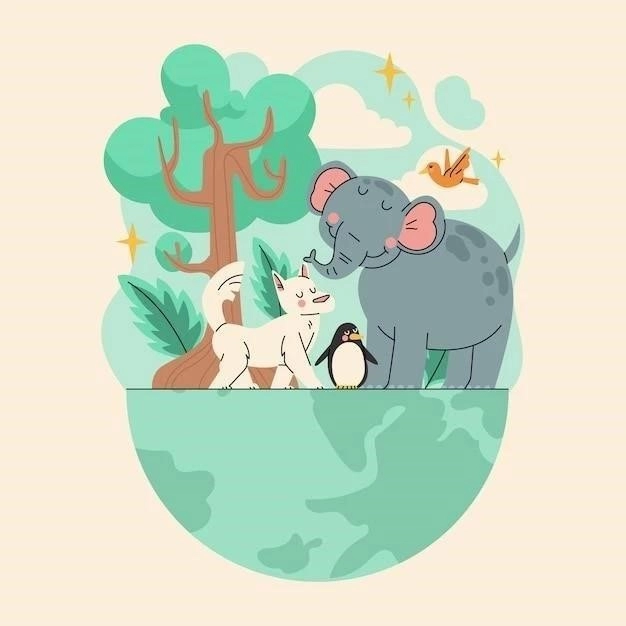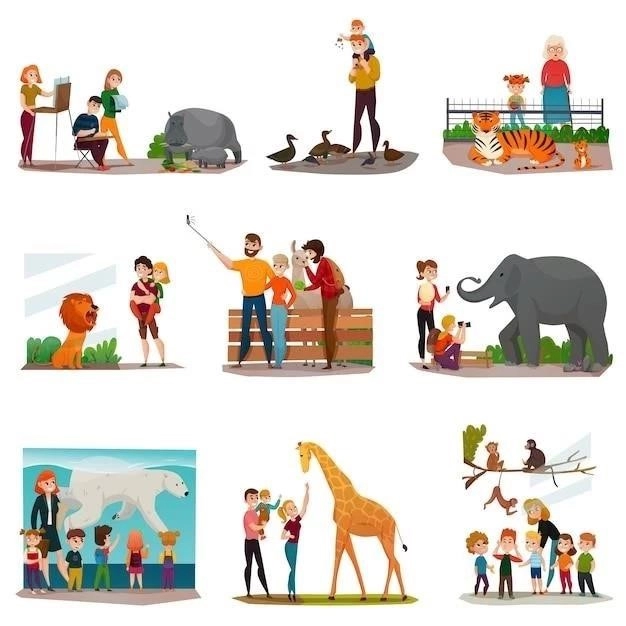I recently visited the San Diego Zoo, and it sparked a thought-provoking question⁚ what is the role of zoos in todays world? Are they purely for entertainment, or do they serve a higher purpose? As I strolled through the meticulously designed habitats, observing animals from the majestic gorillas to the playful penguins, I realized that zoos play a crucial role in animal conservation.
Education and Awareness
Zoos provide a unique opportunity for people like myself, who may not otherwise have the chance, to connect with wildlife. I witnessed firsthand how the zoos interactive exhibits and educational programs taught visitors, especially young children, about animal behavior, habitats, and the threats they face in the wild. This firsthand experience fosters a sense of wonder and responsibility towards the natural world.
Conservation Breeding Programs
One of the most significant contributions of zoos is their involvement in conservation breeding programs. I learned that many zoos participate in Species Survival Plans (SSPs), collaborating to manage the breeding of endangered species. These programs aim to maintain genetically diverse populations and, when possible, reintroduce captive-bred animals back into their natural habitats.

Research and Scientific Advancements
Zoos serve as living laboratories, contributing valuable data to the field of zoology. While at the zoo, I discovered that researchers study animal behavior, reproduction, nutrition, and disease, expanding our understanding of wildlife and informing conservation efforts in the wild. The knowledge gained from these studies helps develop strategies to protect endangered species and their habitats.

Funding and Support for Conservation
Zoos generate revenue through ticket sales, memberships, and donations, and many reinvest these funds into conservation projects worldwide. I was impressed to learn that the San Diego Zoo, for instance, supports over 140 conservation projects in 35 countries. By visiting accredited zoos, we contribute to these efforts and support the protection of wildlife and their habitats.
Challenges and Ethical Considerations
While zoos play a vital role in conservation, its essential to acknowledge the ethical considerations surrounding keeping animals in captivity. I believe that zoos must prioritize animal welfare, providing spacious and stimulating environments that mimic their natural habitats as closely as possible. Additionally, continued efforts must be made to ensure that captive breeding programs contribute directly to the long-term survival of species in the wild.
Conclusion
My visit to the San Diego Zoo solidified my belief that zoos are essential for animal conservation. By connecting people with wildlife, participating in breeding programs, conducting research, and funding conservation efforts, zoos contribute significantly to the preservation of biodiversity. As we face increasing threats to the natural world, its crucial to support accredited zoos and their vital role in protecting our planets incredible animals for generations to come.
Leaving the San Diego Zoo, I felt a sense of hope mingled with a newfound determination. The experience had ignited a passion within me to learn more about wildlife conservation and contribute in any way I could. I decided to start small, making conscious choices in my daily life to reduce my environmental impact. I swapped single-use plastics for reusable alternatives, cut down on my meat consumption, and started supporting organizations dedicated to protecting endangered species.
A few months later, I stumbled upon a local wildlife rehabilitation center in need of volunteers. I eagerly signed up, excited by the opportunity to work directly with animals in need. My first day was both humbling and exhilarating. I assisted in feeding orphaned squirrels, cleaning enclosures, and preparing enrichment activities for recovering birds of prey. It was physically demanding work, but the rewards were immeasurable. Witnessing these animals regain their strength and prepare for release back into the wild filled me with a profound sense of purpose.
Volunteering at the rehabilitation center opened my eyes to the plight of animals affected by habitat loss, pollution, and human-wildlife conflict. It reinforced the importance of zoos not only as conservation centers but also as advocates for change. I realized that educating ourselves and future generations about the interconnectedness of all living things is paramount to ensuring a future where both wildlife and humans can thrive.
Inspired by my experiences, I decided to take my commitment a step further. I enrolled in online courses about conservation biology and wildlife management, eager to deepen my understanding of the science behind protecting endangered species. The courses were challenging but incredibly rewarding. I learned about the intricate workings of ecosystems, the devastating impact of human activities on wildlife populations, and the innovative strategies being employed to mitigate these threats.
Armed with newfound knowledge, I felt compelled to share my passion with others. I started small, giving presentations about wildlife conservation at my local library and community center. To my surprise, the response was overwhelmingly positive. People were genuinely interested in learning about the challenges facing wildlife and eager to discover ways they could make a difference.
Encouraged by this positive feedback, I decided to launch a blog dedicated to showcasing the stories of individuals and organizations working tirelessly on the frontlines of conservation. I spent hours researching and interviewing passionate conservationists, wildlife biologists, and zookeepers, eager to share their inspiring work with a wider audience. Through my blog, I was able to shed light on lesser-known conservation initiatives, highlight the plight of critically endangered species, and provide practical tips for how individuals could live more sustainably.
My journey from zoo visitor to wildlife advocate has been both transformative and deeply fulfilling. It has taught me the importance of embracing opportunities for learning, using my voice to advocate for change, and never underestimating the power of individual action. I am eternally grateful for that fateful visit to the San Diego Zoo, which sparked a lifelong passion for protecting our planets incredible biodiversity.
As my blog gained traction, I started receiving invitations to speak at local schools and events. Sharing my passion for wildlife conservation with younger generations filled me with an incredible sense of purpose. I tailored my presentations to be engaging and interactive, incorporating captivating photos, videos, and even bringing along biofacts like animal skulls and pelts.
Ill never forget the look on a young boys face when he held a shed snakeskin for the first time. His eyes widened in awe as he traced the delicate patterns with his fingers, peppering me with questions about snakes and their role in the ecosystem. It was moments like these that fueled my desire to continue learning and sharing my knowledge.
My conservation journey eventually led me to volunteer with a local organization dedicated to protecting a threatened population of sea turtles. Every summer, I joined a team of dedicated volunteers patrolling nesting beaches at night, carefully relocating vulnerable nests to protected hatcheries. Witnessing these ancient creatures lumbering ashore under the cover of darkness to lay their eggs was a truly humbling experience. It filled me with a profound respect for the delicate balance of nature and the urgent need to protect these magnificent creatures from the threats they face.
One particularly memorable night, we came across a loggerhead turtle struggling to return to the ocean after laying her eggs. The exhaustion was evident in her heavy breaths and labored movements. We carefully approached, our headlamps illuminating her massive shell, and gently guided her towards the waters edge. As the waves gently lapped at her flippers, she seemed to gather her remaining strength and disappeared into the darkness. It was a powerful reminder of the resilience of nature and the impact that even a small group of dedicated individuals can have.
My experiences have taught me that conservation is not a spectator sport. It requires active participation, a willingness to learn, and a commitment to making a difference. Whether its reducing our environmental footprint, supporting conservation organizations, or simply spreading awareness about the plight of endangered species, every action, no matter how small, can contribute to a healthier planet for all.










